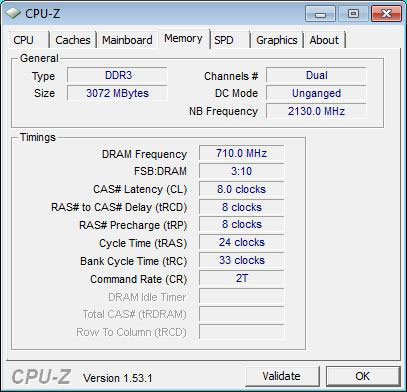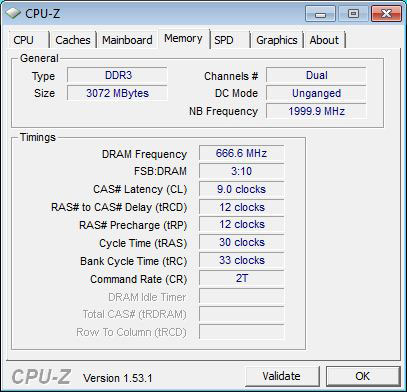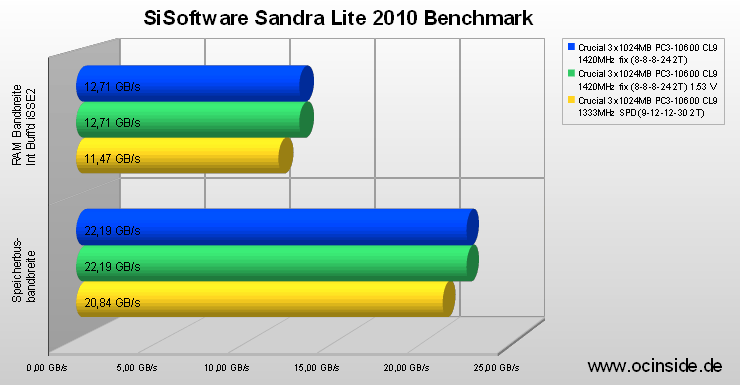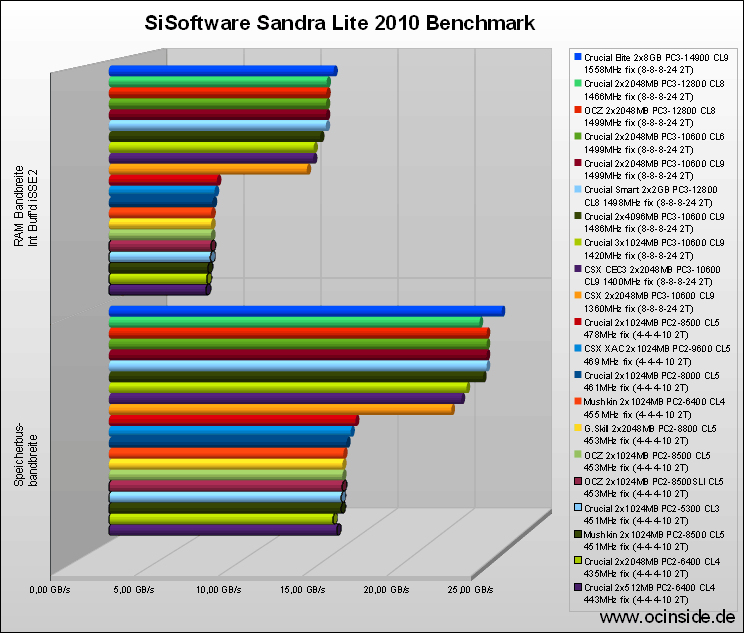
Let us continue with the most important part of the test report, the highest possible stable performance. The multiplier adjustment remains on 13x with all frequencies, because an adjustment for the CPU in half multiplier steps would be too inaccurate to get nearly the same CPU frequency for all tests. Microsoft Windows 7 RC Ultimate Edition is used as the operating system. The stability was examined with the software Memtest86
and SiSoft Sandra Lite 2010c program is used for all benchmarks, since it offers extensive adjustments and a fast result comparison. BTW. the latest SiSoftware Sandra 2010c version is available on our download server and can be downloaded very fast. All benchmarks are also included in the free Sandra Lite version.
First the maximum possible frequency of the memory module was determined with default 1.50 Volt (1,53V). The memory frequency was increased in small steps with a fixed memory timing of 8-8-8-24 2T and default memory voltage, as long as the detailed memory test with Memtest86 runs without any errors. This quite long testing time ensured that this frequency works really stable with these modules.
The highest possible frequency with 8-8-8-24 2T (CAS-TRCD-TRP-TRAS) timings and 1.53V was 710 / 1420 MHz.
Here is a Snipping screenshot of CPU-Z 1.53 with 710 / 1420 MHz and 8-8-8-24 2T with 1.53 Volt:

Of course it’s possible to run much higher frequencies with increased voltages or lower timings, because the frequency values and timings depends directly from each other. But officially Crucial specify only a voltage of 1.50 Volt without loosing the warranty. The voltage should not be increased very much without additional cooling modifications.
The benchmark comparison of all DDR3 memory modules were tested with the default 1.53 V, where these Crucial 1GB modules reached 1420 MHz. This highest possible clocking on the default DDR3 voltage was compared now with two other settings. On the one hand they were tested with 200 MHz reference clock x6,66 = 1333 MHz and SPD values (SPD values are programmed in the SPD IC by the manufacturer). On the other hand the highest possible frequency with the permitted manufacturers voltage was determined at 8-8-8-24 2T. But in case of these modules the highest voltage is identical with the lowest test voltage, so the second test is equal to the first result.
With a frequency of approx. 667 MHz the SPD EEPROM autodetection timings were 9-12-12-30 2T (CAS-TRCD-TRP-TRAS).
Here is a Snipping screenshot of CPU-Z 1.53 with 666.7 / 1333 MHz and 9-12-12-30 2T:

Comparison between one, two and three memory modules on an AMD Phenom II system …
Additionally to the official benchmark test, a comparison of one, two and three 1GB memory modules on an AMD Phenom II platform shows the performance difference between Single Channel and Dual Channel, and shows if there is a disadvantage of a Triple Channel kit on this Dual Channel platform. All of the following values are measured with the same frequency and timing on an AMD Phenom II test system:
| Memory Kit | Memory Bandwidth | RAM Range Int Buff’d iSSE2 | Memory Bus Range | Memory Latency |
| 3x 1GB | Dual Channel Mode | 12.74 GB/s | 21.88 GB/s | 84 ns |
| 2x 1GB | Dual Channel Mode | 12.63 GB/s | 21.88 GB/s | 84 ns |
| 1x 1GB | Single Channel Mode | 8 GB/s | 11 GB/s | 83 ns |
The values shows that the memory performance is almost identical in SiSoftware Sandra 2010c when using two or three memory modules. The memory controller only changed to the full Single Channel mode when using just one memory module and this results in high losses of the RAM range and the memory bus range. According to the motherboard manual, the combination of three modules would not run in DC mode. However, with the combination of three modules, the Dual Channel mode was recognized by the motherboard. So the test platform with an AMD in unganged mode was able to operate two thirds of the memory in the Dual Channel mode. A Triple Channel kit was thus not very disadvantageful in this test with the AMD Phenom II system. It depends on the motherboard and CPU, if three modules or different asymmetric memory combinations will run in the Dual Channel mode and should be explained in the documents of the respective manufacturer.
The difference between unganged and ganged mode is already described in previous ocinside.de Phenom and Phenom II motherboard test reports, here is again an excerpt for better understanding: In unganged mode it has two separate 64bit DCT (DRAM Controller) which can be application-oriented much faster with two or more CPU cores. In contrast to it, single threaded applications can profit with the simple 128bit ganged mode (ganged is by the way necessary for the ECC error correction). Once again the difference between ganged and unganged in shortform: ganged = Single Dual Channel = 1x128bit = better for single threaded applications and ECC unganged = Dual Single Channel = 2x64bit = better for multi threaded applications
Let us continue with the official benchmark results …
Here are the SiSoftware Sandra 2010 benchmark results:
| Frequency | Timing | Memory Voltage | RAM Range Int Buff’d iSSE2 | Memory Bus Range | Memory Latency |
| 213 MHz * 6.66 = 1420 MHz | fix (8-8-8-24 2T) | 1.53 Volt | 12.71 GB/s | 22.19 GB/s | 80 ns |
| 213 MHz * 6.66 = 1420 MHz | fix (8-8-8-24 2T) | 1.53 Volt | 12.71 GB/s | 22.19 GB/s | 80 ns |
| 200 MHz * 6.66 = 1333 MHz | SPD (9-12-12-30 2T) | 1.53 Volt | 11.47 GB/s | 20.84 GB/s | 92 ns |
By the way, the “Memory Bus Range” is no benchmark value, but this value is quite simple to calculate by the frequency and this is useful for a benchmark comparison.
Here’s a diagram of the benchmark values:

Here is a direct benchmark result comparison of some DDR3, DDR2 and DDR memory modules:

The three 1GB modules reached the fifth place concerning the highest overclocking with a JEDEC DDR3 voltage of 1.5V. So the Crucial 3GB PC3-10600 Triple Channel kit is at present approx. in the middle of all DDR3 modules tested so far.

